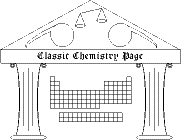Rayleigh nitrogen statistics
The discovery of the element argon by Lord Rayleigh and William Ramsay had its origins in Rayleigh's measurements of the density of nitrogen with an eye toward accurate determination of its molar mass. Rayleigh prepared some samples by removing oxygen, carbon dioxide, and water vapor from atmospheric air; he prepared other samples by chemical reaction of nitrogen-containing compounds and subsequent purification. In any event, the final measurement was of the mass of a purified sample that filled a glass globe under certain standard conditions. This set of exercises examines some of Rayleigh's gas density measurements in greater detail.
1) Rayleigh prepared nitrogen from urea by oxidizing the nitrogen with sodium hypochlorite:
(NH2)2CO + 3 NaOCl -- > N2 + CO2 + 2 H2O + 3 NaCl .
The masses of a standard quantity of urea-derived nitrogen for several trials were:
| sample date | mass (g)
|
| June 6 | 2.2978
|
| June 9 | 2.2987
|
| June 13 | 2.2982
|
| June 19 | 2.2994
|
Report the mean mass and the standard deviation of these measurements.
2) Rayleigh prepared nitrogen samples of atmospheric origin by several purification methods. The masses of his standard quantity are reported below, each number representing the mean of several trials.
| ATMOSPHERIC NITROGEN.
|
|---|
| purification method | mass (g)
|
| By hot copper (1892) | 2.3103
|
| By hot iron (1893) | 2.3100
|
| By ferrous hydrate (1894) | 2.3102
|
Similarly he reported the masses of samples of several different "chemical" origins (that is, derived by chemical reactions of different nitrogen-containing compounds). The masses are reported below, again each number representing multiple trials.
| CHEMICAL NITROGEN.
|
|---|
| From nitric oxide | 2.3001
|
| From nitrous oxide | 2.2990
|
| From ammonium nitrite purified at a red heat | 2.2987
|
| From urea | 2.2985
|
| From ammonium nitrite purified in the cold | 2.2987
|
a) Report the mean mass and standard deviation of "atmospheric nitrogen" and of "chemical nitrogen."
b) For the purposes of this exercise, take "chemical nitrogen" to be the true value. What is the percent error of "atmospheric nitrogen"?
c) Is the small difference between "chemical nitrogen" and "atmospheric nitrogen" likely to be within experimental error or is it likely to be due to a physical difference between the two sets of samples? Explain with reference to the data.
3) The mean and standard deviation can be used to define a "normal" distribution, a bell-shaped curve that represents the relative probability of a measurement having a particular value. The distribution function is:
f(x) = exp[-(m-mavg)2/2s2]/[s(2π)1/2] ,
where mavg is the mean and s the standard deviation. Based on the means and standard deviations computed in exercise 2, plot the normal distributions of "chemical nitrogen" and "atmospheric nitrogen." Answer question (2c) with reference to the plot of distributions.
References
- Lord Rayleigh & William Ramsay, "Argon, A New Constituent of the Atmosphere," Philosophical Transactions of the Royal Society of London A 186, 187-241 (1895)
- Lord Rayleigh, "Argon," Royal Institution Proceedings 14, 524-538 (1895)
Copyright 2003 by Carmen Giunta. Permission is granted to reproduce for non-commercial educational purposes.

| Back to the top of the Classic Chemistry site |